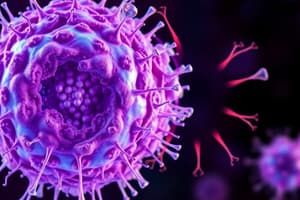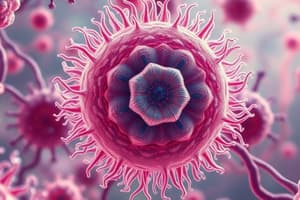Podcast
Questions and Answers
Which of the following is a characteristic unique to prokaryotic cells?
Which of the following is a characteristic unique to prokaryotic cells?
- Organization into multicellular structures
- Presence of a true nucleus
- Cell size ranging from 10−100 µm
- Genetic material suspended in the nucleoid (correct)
What are the common shapes associated with prokaryotic cells?
What are the common shapes associated with prokaryotic cells?
- Chains, clusters, and sheets
- Cylinders, disks, and spikes
- Spheres, rods, and spirals (correct)
- Squares, pentagons, and hexagons
In which types of organisms would you typically find eukaryotic cells?
In which types of organisms would you typically find eukaryotic cells?
- Bacteria and archaea
- Viruses and prions
- Plants, fungi, protozoa, and animals (correct)
- Algae and yeast only
How does the size of prokaryotic cells typically compare to eukaryotic cells?
How does the size of prokaryotic cells typically compare to eukaryotic cells?
What type of hereditary material can be found in prokaryotic cells?
What type of hereditary material can be found in prokaryotic cells?
What distinguishes the nucleus in eukaryotic cells?
What distinguishes the nucleus in eukaryotic cells?
Which of the following statements about prokaryotic cells is correct?
Which of the following statements about prokaryotic cells is correct?
Which feature is not found in prokaryotic cells?
Which feature is not found in prokaryotic cells?
What is the complementary DNA sequence for the single-stranded DNA molecule 5'─GGATCTGATCCAGTCA─3'?
What is the complementary DNA sequence for the single-stranded DNA molecule 5'─GGATCTGATCCAGTCA─3'?
Which statement correctly describes a key difference between prokaryotic and eukaryotic cells?
Which statement correctly describes a key difference between prokaryotic and eukaryotic cells?
Which of the following is NOT a characteristic of prokaryotic cells?
Which of the following is NOT a characteristic of prokaryotic cells?
What is the primary focus of cell biology?
What is the primary focus of cell biology?
In the context of genetic sequences, what does the order of DNA bases determine?
In the context of genetic sequences, what does the order of DNA bases determine?
Which of the following organisms is classified as a eukaryote?
Which of the following organisms is classified as a eukaryote?
What percentage of thymine would be expected in a double-stranded DNA that has 20% of cytosine?
What percentage of thymine would be expected in a double-stranded DNA that has 20% of cytosine?
What distinguishes eukaryotic cells from prokaryotic cells at the cellular level?
What distinguishes eukaryotic cells from prokaryotic cells at the cellular level?
If a double-stranded DNA molecule contains 38% adenine, what is the percentage of guanine in that molecule?
If a double-stranded DNA molecule contains 38% adenine, what is the percentage of guanine in that molecule?
What role do the sequences of DNA bases play in genetic coding?
What role do the sequences of DNA bases play in genetic coding?
In the context of cell biology, what is the significance of categorizing cells into eukaryotic and prokaryotic?
In the context of cell biology, what is the significance of categorizing cells into eukaryotic and prokaryotic?
Flashcards are hidden until you start studying
Study Notes
Study of Cells (Cell Biology)
- Cell is the basic structural and functional unit of life
- Cells provide structure and function for all living things, from microorganisms to humans
- The study of cell structure and functions is called cell biology
- Two classic categories of cells based on cellular structures: eukaryotic and prokaryotic cells
Prokaryotes
- Mostly single-celled (unicellular) microorganisms
- Examples include archaea and bacteria
- Cell size ranges from 1 to 5 µm in diameter
- Hereditary material can be DNA or RNA
- Genetic material is freely suspended in the region called nucleoid
- Three common shapes: spheres, rods, and spirals
Eukaryotes
- Characterized by a true nucleus
- Examples include plants, fungi, protozoa, and animals
- Cell size ranges between 10-100 µm in diameter
- Hereditary material DNA is packed in the nucleus
Prokaryotes vs Eukaryotes
- Prokaryotic cells lack a true nucleus.
- Eukaryotic cells contain a true, membrane-bounded nucleus.
- Prokaryotes are mostly single-celled microorganisms, including archaea and bacteria.
- Eukaryotes encompass a wider range, including plants, fungi, protozoa, and animals.
- Prokaryotic cells have a cell size ranging from 1 to 5 µm in diameter.
- Eukaryotic cells have a cell size ranging between 10−100 µm in diameter.
- Prokaryotes can have DNA or RNA as their genetic material, which is freely suspended within the nucleoid region.
- Eukaryotes have DNA as their genetic material, which is packed within a defined nucleus.
Cell Biology
- The cell is the fundamental unit of life, providing both structure and function for living organisms.
- The discipline of studying cellular structure and functions is known as cell biology.
- Based on their cellular structures, cells are broadly categorized into two types: eukaryotic and prokaryotic cells.
Prokaryotes
- Prokaryotes have three common shapes: spheres, rods, and spirals.
Eukaryotes
- Eukaryotic cells are generally larger in size than prokaryotic cells.
Studying That Suits You
Use AI to generate personalized quizzes and flashcards to suit your learning preferences.




